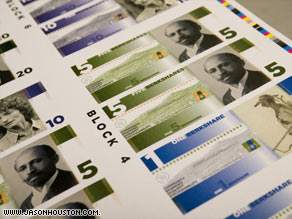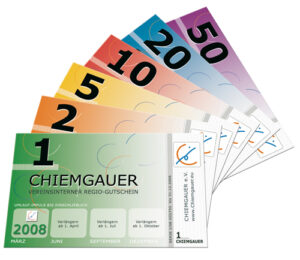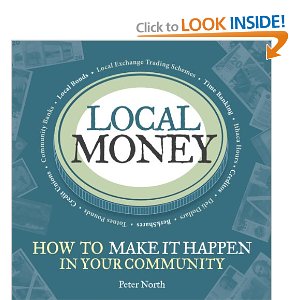In economics, a local currency, in its common usage, is a currency not backed by a national government (and not necessarily legal tender), and intended to trade only in a small area. As a tool of fiscal localism, local moneys can raise awareness of the state of the local economy, especially among those who may be unfamiliar or uncomfortable with traditional bartering. These currencies are also referred to as community currency, and are a form of alternative currency or complementary currency. They encompass a wide range of forms, both physically and financially, and often are associated with a particular economic discourse.
 The Brixton Pound (B£) is money that sticks to Brixton. It’s designed to support Brixton businesses and encourage local trade and production. It’s a complementary currency, working alongside (not replacing) pounds sterling, for use by independent local shops and traders. The B£ is the UK’s first local currency in an urban area and the fourth transition town to have its own currency, following the Totnes Pound in Devon, Lewes Pound in Sussex and Stroud Pound in Gloucestershire. The notes are available in B£1, B£5, B£10 and B£20 denominations and depict local celebrities such as the community activist Olive Morris and the environmentalist James Lovelock. Lambeth council has endorsed the project which the New Economics Foundation helped to develop. On September 29, 2011, the Brixton Pound launched an electronic version of the currency where users can pay by text message.
The Brixton Pound (B£) is money that sticks to Brixton. It’s designed to support Brixton businesses and encourage local trade and production. It’s a complementary currency, working alongside (not replacing) pounds sterling, for use by independent local shops and traders. The B£ is the UK’s first local currency in an urban area and the fourth transition town to have its own currency, following the Totnes Pound in Devon, Lewes Pound in Sussex and Stroud Pound in Gloucestershire. The notes are available in B£1, B£5, B£10 and B£20 denominations and depict local celebrities such as the community activist Olive Morris and the environmentalist James Lovelock. Lambeth council has endorsed the project which the New Economics Foundation helped to develop. On September 29, 2011, the Brixton Pound launched an electronic version of the currency where users can pay by text message.
 BerkShares are a local currency for the Berkshire region of Massachusetts. Dubbed a “great economic experiment” by the New York Times, BerkShares are a tool for community empowerment, enabling merchants and consumers to plant the seeds for an alternative economic future for their communities. Launched in the fall of 2006, BerkShares had a robust initiation, with over one million BerkShares having been circulated in the first nine months and over 2.7 million to date. Currently, more than four hundred businesses have signed up to accept the currency. Five different banks have partnered with BerkShares, with a total of thirteen branch offices now serving as exchange stations. For BerkShares, this is only the beginning. Future plans could involve BerkShares checking accounts, electronic transfer of funds, ATM machines, and even a loan program to facilitate the creation of new, local businesses manufacturing more of the goods that are used locally.
BerkShares are a local currency for the Berkshire region of Massachusetts. Dubbed a “great economic experiment” by the New York Times, BerkShares are a tool for community empowerment, enabling merchants and consumers to plant the seeds for an alternative economic future for their communities. Launched in the fall of 2006, BerkShares had a robust initiation, with over one million BerkShares having been circulated in the first nine months and over 2.7 million to date. Currently, more than four hundred businesses have signed up to accept the currency. Five different banks have partnered with BerkShares, with a total of thirteen branch offices now serving as exchange stations. For BerkShares, this is only the beginning. Future plans could involve BerkShares checking accounts, electronic transfer of funds, ATM machines, and even a loan program to facilitate the creation of new, local businesses manufacturing more of the goods that are used locally.
 Chiemgauer is the name of a regional local currency started in 2003 in Prien am Chiemsee, Bavaria, Germany. It is named after the Chiemgau, a region around the Chiemsee. The Chiemgauer program is intended to promote local commerce. The Chiemgauer operates with a fixed exchange rate: 1 Chiemgauer = €1. Bills of 1, 2, 5, 10, 20, and 50 Chiemgauer are issued. To maintain an individual bill’s validity, a “scrip” corresponding to 2% of the banknote value must be paid every three months. (This system, called demurrage, is a form of currency circulation tax and was invented by Silvio Gesell.)
Chiemgauer is the name of a regional local currency started in 2003 in Prien am Chiemsee, Bavaria, Germany. It is named after the Chiemgau, a region around the Chiemsee. The Chiemgauer program is intended to promote local commerce. The Chiemgauer operates with a fixed exchange rate: 1 Chiemgauer = €1. Bills of 1, 2, 5, 10, 20, and 50 Chiemgauer are issued. To maintain an individual bill’s validity, a “scrip” corresponding to 2% of the banknote value must be paid every three months. (This system, called demurrage, is a form of currency circulation tax and was invented by Silvio Gesell.)
Chiemgauer, considered to be equivalent to the euro, circulates as follows within Prien and neighboring towns:
- Non-profits: entitled to purchase 100 Chiemgauer at €97 and resell them at €100, therefore earning €3 to be spent for their own activities.
- Shoppers: exchange €100 for 100 Chiemgauer at a non-profit they support, allowing the non-profit to benefit from the preferential purchase price. Also, spend Chiemgauer at local businesses at face value, therefore helping both local non-profits and businesses without any further cost.
- Businesses: accept 100 Chiemgauer at face value and spend them for their own purchases or exchange 100 Chiemgauer into €95, losing 5% for commission but earning more by attracting Chiemgauer members to their products and/or services. Of this, €2 is devoted to administrative costs, and €3 replaces the original discount to the non-profit.
 Local Money by Peter North shows how local currency can help us unleash the financial power of our communities to build a resilient, low-carbon future.In past recessions and depressions, a popular response from communities has been to create their own forms of money. The jobs aren’t there, and the money has dried up, but needs remain. How can local money help communities in times of hardship and cut as much carbon out of their economies as possible?An inspiring and practical new book, Local Money helps you understand what money is and what makes good and bad money. It draws on the considerable track record of experimentation with local money around the world and gives ideas to those in the Transition movement and beyond about what has been tried, what works, and what to avoid.Different models of alternative currencies are reviewed, from the Local Exchange Trading System (LETS) and Timebanks that work within communities, to paper currencies such as Berkshares, German regional currencies and Ithaca ‘hours’ that circulate between local businesses as an alternative to their losing trade to the big box retailers.How can local banks and bonds help us move our cities, communities and homes on to a more sustainable footing? The book suggests how groups can create future forms of local money that can deepen local resilience and support the development of more local production of the things we need, such as food and power, while also reducing a community’s CO2 emissions.
Local Money by Peter North shows how local currency can help us unleash the financial power of our communities to build a resilient, low-carbon future.In past recessions and depressions, a popular response from communities has been to create their own forms of money. The jobs aren’t there, and the money has dried up, but needs remain. How can local money help communities in times of hardship and cut as much carbon out of their economies as possible?An inspiring and practical new book, Local Money helps you understand what money is and what makes good and bad money. It draws on the considerable track record of experimentation with local money around the world and gives ideas to those in the Transition movement and beyond about what has been tried, what works, and what to avoid.Different models of alternative currencies are reviewed, from the Local Exchange Trading System (LETS) and Timebanks that work within communities, to paper currencies such as Berkshares, German regional currencies and Ithaca ‘hours’ that circulate between local businesses as an alternative to their losing trade to the big box retailers.How can local banks and bonds help us move our cities, communities and homes on to a more sustainable footing? The book suggests how groups can create future forms of local money that can deepen local resilience and support the development of more local production of the things we need, such as food and power, while also reducing a community’s CO2 emissions.
